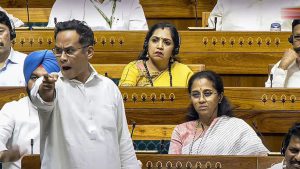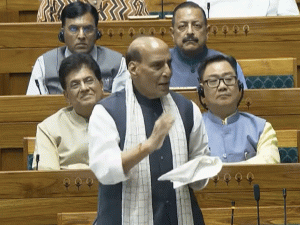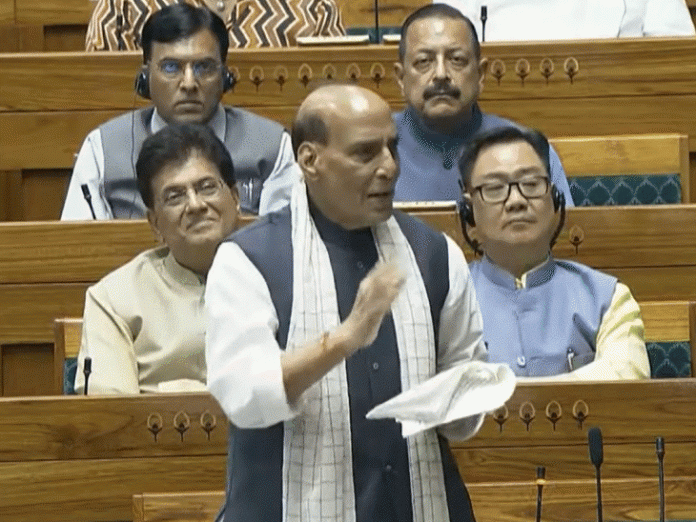Synopsis:
Operation Sindoor triggered a heated Lok Sabha debate as opposition leaders demanded transparency on India’s military losses and intelligence failures. Focus shifted to unanswered questions about the Pahalgam attack and government silence on the true cost of the operation.
New Delhi | Qalam Times News Network
Operation Sindoor became the lightning rod for a sharp and deeply political confrontation in the Lok Sabha on Monday, with members clashing over military transparency, intelligence lapses, and national security. What was meant to be a post-facto assessment of the government’s counterterrorism response turned into an intense back-and-forth, especially between Defence Minister Rajnath Singh and Congress MP Gaurav Gogoi.


The conversation was meant to analyze the aftermath of the April 22 terrorist attack in Pahalgam, Jammu & Kashmir, carried out by The Resistance Front, an affiliate of Lashkar-e-Taiba. In response to that attack, India had launched Operation Sindoor on May 7 — a 25-minute precision strike on terror bases in Pakistan and Pakistan-occupied Kashmir (PoK). Government sources claimed over 100 militants were neutralized, followed by a ceasefire on May 10, allegedly brokered through economic pressure by U.S. President Donald Trump. However, Pakistan responded with its own claims of having shot down several Indian fighter jets — and that’s where the political storm truly began.
Opposition Turns the Heat On Operation Sindoor
Congress’s Gaurav Gogoi spearheaded the opposition’s offensive. Taking the floor, he raised pointed questions about the cost of Operation Sindoor, asking, “How many of our Rafale jets were shot down? We only have 35. Losing even a few is a massive national loss.” Citing a statement attributed to Indian Air Force Captain Shiv Kumar, Gogoi alleged that initial setbacks were caused by the government’s restricted engagement policy — targeting only terror camps and avoiding Pakistani military infrastructure or air defenses.
He went further, questioning how terrorists managed to reach Pahalgam in the first place despite India’s advanced intelligence infrastructure — drones, Pegasus spyware, satellites, CRPF, BSF, and CISF. “It’s been 100 days. The five terrorists involved are still free. Where is the accountability?” he asked, adding that even tour operators were scapegoated instead of any serious administrative responsibility being taken.
Rajnath Singh Fires Back
Defence Minister Rajnath Singh responded firmly, defending Operation Sindoor as a “decisive and successful mission.” He accused the opposition of politicizing a sensitive issue and dishonoring national sentiment. “You ask how many of our planes went down, but not how many enemy jets we destroyed,” Singh retorted, refusing to confirm losses. He stressed that not a single Indian soldier had died in the operation and compared India’s retaliation to Lord Hanuman’s burning of Lanka — targeted, focused, and symbolic.
He insisted the operation wasn’t about territorial expansion but a message to those sheltering terror. “India hit where it hurts, and that’s enough,” he said.
Trump’s Claim and the Ceasefire Question on Operation Sindoor
Gogoi wasn’t done. He brought up President Trump’s repeated claim — made 26 times publicly — that he forced both India and Pakistan into a ceasefire. “Who did our Prime Minister surrender to?” Gogoi demanded. He drew parallels to earlier government narratives after the Uri and Pulwama attacks and asked, “If we destroyed all terror infrastructure then, how did Pahalgam happen?”
Another thorny point was the timing of the ceasefire. “If Pakistan was on the back foot, why did we stop? Why did we not reclaim PoK?” he asked, connecting military restraint with political cowardice.
Panda’s Jab and Tharoor’s Name Drop
As the debate wore on, BJP MP Baijayant Panda took a cheeky swipe at the Congress for fielding weaker debaters. When an opposition MP remarked that the discussion was ‘not interesting,’ Panda quipped, “It would have been more engaging if Congress had allowed some of its better speakers, like Shashi Tharoor, to participate.”
Underneath the Fireworks: A Demand for Clarity
While the rhetoric was sharp and the blame game predictable, the underlying demand remained serious: transparency. The opposition wants the government to publicly state the real cost of Operation Sindoor—in terms of aircraft, intelligence failures, and unanswered questions from Pahalgam. The government, meanwhile, wants to frame it as a tactical and symbolic victory in the war on terror.
Outside the halls of Parliament, the public watches with unease, caught between chest-thumping nationalism and a gnawing desire for clarity. And as long as key facts remain classified or distorted, debates like these aren’t going anywhere.








on9seb
https://shorturl.fm/ilVjC